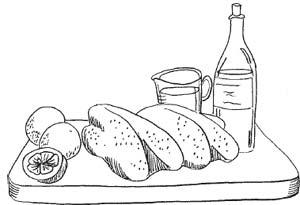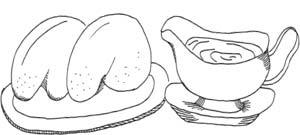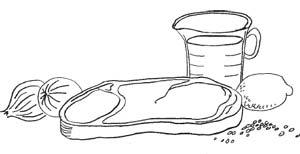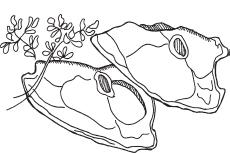Authors: Sally Fallon,Pat Connolly,Phd. Mary G. Enig
Tags: #Non-Fiction, #Reference, #Science, #Health
Nourishing Traditions: The Cookbook That Challenges Politically Correct Nutrition and The... (92 page)


TERIYAKI QUAIL
Serves 6
12 quail, ribs removed and torso opened out
2 cups
teriyaki sauce
Marinate quail several hours or overnight in teriyaki sauce. Grill under broiler about 10 minutes per side or cook on the barbecue. Eat with fingers—this is the only way to eat quail!
The San Diego Indians of Southern California changed their home sites with the supply of native foods. They fished from the ocean, hunted the plentiful game on the mountains, and gathered acorns, seeds and wild greens when in season. They collected wild onion and sage for seasoning. Their staple meal was acorn mush, eaten from a common pot. The acorns were prepared by grinding on basaltic stones, leaching in sand, or pounding with rocks, which introduced much abrasive material to wear down the tooth enamel but at the same time prevented cavities. The acorn mush, supplemented with wild game, seafood and greens, supplied them with all the necessary nutrients. They kept rabbits, quail and other game birds in holes and baskets, and prepared dishes with the whole animals. Early explorers and missionaries of the San Diego area reported that the local Indians were strong, hardy and seldom ill. But later studies indicate that when the Indians were deprived of their natural foods by living on reservations and eating modern foods, most of them suffered a sharp decrease in general health and within a single generation became susceptible to eye diseases, a high tooth decay rate, bowed legs and tuberculosis. "Nutrition: The Appetite of Man" PPNF

Every moving thing that liveth shall be meat for you; even as the green herb have I given you all things.
Gen 9:3
QUAIL MASALA
Serves 6
12 quail, ribs removed and torso opened out
1 cup yoghurt
1 medium onion, peeled and finely chopped
3 cloves garlic, peeled and crushed
1 teaspoon grated fresh ginger
1 teaspoon ground cumin
½ teaspoon turmeric
½ teaspoon ground cardamom
¼ teaspoon ground cloves
¼ teaspoon cinnamon
¼ teaspoon cayenne pepper
1 teaspoon sea salt
1 bunch cilantro, chopped
Mix yoghurt and remaining ingredients together. Marinate quail in yoghurt mixture several hours or overnight. Grill under broiler about 10 minutes per side or cook on the barbecue. Eat them with your fingers—no knives or forks allowed.
Politically Correct Nutrition has singled out red meat—beef and lamb—as a major contributing factor, or even the main cause, of our two greatest plagues—cancer and heart disease. Consumption of these meats has dropped in recent years, but the incidence of both heart disease and cancer continue to climb.
What light can the practices of traditional societies shed on the question of red meat? Surveys of ethnic diets show that red meat in the form of beef, sheep and goat is the second most preferred source of animal protein and fat in nonindustrialized societies, second only to chicken (flesh and eggs) and more popular, or at least more available, than foods from the sea. These societies rarely suffer from cancer and heart disease. This fact alone should be enough to allay any fears about red meat.
The dangers inherent in red meat are due, we believe, to modern methods of raising cattle. Most commercially available red meat comes from animals that have been raised in huge feedlots on grains laden with pesticides—or worse on soy feed which is too high in protein and therefore toxic to their livers—injected with steroids to make their meat tender and treated with antibiotics to stave off infections that inevitably result from poor diet and crowded conditions.
Fortunately, organically raised, pasture-fed beef is now becoming more available. Cattle and sheep should spend most of their life on the open range. However, it is entirely appropriate for these animals to be fattened on grain during their last few weeks. Such practices imitate natural processes, as ruminant animals get fat on seeds and grains in their natural habitat during summer and fall. Grain feeding is an ancient practice that ensures that red meat contains ample amounts of fat. It should, however, be carried out in healthy, uncrowded conditions.
If you eat red meat, we urge you to make every effort to obtain meat that has been raised mostly on pasture. Many markets in our larger cities now sell organically raised or pasture-fed beef, and with a little searching a wholesale supply can always be found. Many farmers will sell sides or quarters directly to consumers. If you have freezer space, this is the most economical way to buy good quality beef and veal. (Be sure to specify, when buying sides of meat directly from a farmer, that the meat be hung and allowed to age, like commercial meat, before it is packaged for your freezer. Otherwise it will be very tough.) Both domestic and imported lamb is, for the most part, pasture fed and can be purchased from regular supermarkets.
When you purchase directly from the farm, you have the additional advantage of being able to obtain organ meats, bones and hooves. Traditional societies do not let these valuable parts go to waste. The organ meats, extremely rich in fat-soluble vitamins, are relished as delicacies in primitive societies; and the bones and hooves are used to make nutritious stocks that provide abundant minerals in a form that is particularly easy to assimilate.
Red meat is an excellent source of both macro and trace minerals, particularly zinc and magnesium. In meat, these minerals exist in a form that is much easier for the body to break down and utilize than the minerals in grains and pulses. Red meats are rich in vitamin B
12
, so important for a healthy nervous system and blood; and in carnitine, which is essential for healthy functioning of the heart. Beef and lamb fat contain fat-soluble vitamins and small amounts of essential fatty acids, especially if these animals have been allowed to graze on green grass. These fat-soluble vitamins are what your body needs to utilize the minerals in all foods. In animal studies, beef fat has a cholesterol-lowering effect. Lamb and beef fat are rich in conjugated linoleic acid, which has strong anticancer effects; and both lamb and beef fat contain palmitoleic acid, which protects us from viruses and other pathogens.
Our recipes for tender portions of beef and lamb—filet and rib cuts of beef, leg of lamb and lamb chops—call for these cuts to be eaten rare, with most of their enzyme content still intact. Tougher cuts can be braised in stock to make flavorful stews. In braising, the temperature of the meat does not exceed 212 degrees so denaturing of proteins is minimized. The enzyme content is destroyed, but any minerals and amino acids that come out of the meat will be contained in the sauce. Many ethnic recipes call for marinating tougher cuts for 24 to 48 hours in wine, yoghurt or buttermilk. This process tenderizes and predigests the meat.
We do not recommend deep frying of red meats or any cooking methods that raise the internal temperature above 212 degrees. Research indicates that meats subjected to high heats are harder to digest and may even foster the growth of pathogens and viruses in the colon. Here is yet another reason to consume meats with sauce or broth containing gelatin and, hence, hydrophilic colloids to facilitate protein digestion.
We hate to be spoilsports but we must caution you against too frequent consumption of grilled meats. Meat and meat fat that come in contact with open flames synthesize certain highly carcinogenic hydrocarbons. Meat that has been cooked in a pan or in liquid contains very few hydrocarbons in comparison with meat that has been grilled. Your body can deal with these hydrocarbons if it is healthy and not overloaded. We urge you to eat grilled meats only occasionally and, when you do, be sure to eat them with one or more cruciferous vegetables, such as cabbage, broccoli or Brussels sprouts. Even better, serve grilled meats with lacto-fermented vegetables or relishes. The combination is synergistic, not only in terms of flavor but also because the vegetables with their lactic-acid-producing bacteria and high enzyme content will help neutralize carcinogens in the intestinal tract.
PEPPER STEAK
Serves 4
4 small beef tenderloin steaks, cut at least 1-inch thick, or 2 rib eye or T-bone steaks
1 tablespoon dried green peppercorns, crushed
juice of one lemon
1 teaspoon olive oil
2 tablespoons butter
4 shallots or 1 bunch green onions, finely chopped
½ cup red wine
2 cups
beef stock1 tablespoon gelatin (See
Sources
), optionalsea salt and pepper
Crush the peppercorns and mix them with lemon juice. Rub into the steaks and marinate at room temperature for several hours.
Brush a cast-iron skillet with olive oil. Pat the steaks dry, leaving as much pepper adhering to the steaks as possible. Heat the pan and cook steaks in two batches over medium-high flame about 5 minutes to a side or until medium rare. Transfer to a heated platter and keep warm in the oven while making sauce.
Pour out any grease from the pan. Add butter and gently saute the shallots or green onions. Add wine and bring to a rapid boil. Add stock and optional gelatin and skim. Boil rapidly, until sauce is reduced to about
2
/
3
cup. Season to taste. Transfer steaks to individual plates and spoon a little sauce over each.
The Masai are tall and strong. . .. For their food throughout the centuries they have depended very largely on milk, meat and blood, reinforced with vegetables and fruits. In the Masai tribe, a study of 2,516 teeth in eighty-eight individuals distributed through several widely separated manyatas showed only four individuals with caries. These had a total of ten carious teeth, or only 0.4 percent of the teeth attacked by tooth decay. In contrast with the Masai, the Kikuyu tribe are characterized by being primarily an agricultural people. Their chief articles of diet are sweet potatoes, corn, beans, and some bananas, millet, and Kafir corn, a variety of Indian millet. The women use special diets during gestation and lactation. . .. The Kikuyus are not as tall as the Masai and physically they are much less rugged. . .. A study of 1,041 teeth in thirty-three individuals showed fifty-seven teeth with caries or 5.5 percent. There were 36.4 percent of the individuals affected. Weston Price, DDS
Nutrition and Physical Degeneration
There is no society in the world that is entirely vegetarian. The Hindus of India come closest. Dr. H. Leon Abrams reports on India, ". . .the greater percentage of the population, who subsist almost entirely on vegetable foods, suffer from kwashiorkor, other forms of malnutrition, and have the shortest life span in the world." William Campbell Douglass, MD
The Milk Book

QUICK STEAK
Serves 3-4
1½-2 pounds steak such as rib eye or T-bone
1-2 tablespoons cracked pepper
1 tablespoon butter
1 tablespoon extra virgin olive oil
2-4 tablespoons fish sauce (
Fermented Fish Sauce
)1 cup
piima cream
or
creme fraichesea salt
Sprinkle steaks with pepper and press in. Melt butter and olive oil in a heavy skillet. Saute steaks a few minutes on a side, until rare or medium rare. Transfer to a heated platter and keep warm in the oven while making sauce.
Pour out browning fat. Add fish sauce and cream to the pan and bring to a boil, scraping up any accumulated juices with a wooden spoon. Skim sauce and simmer for several minutes until sauce thickens. Season to taste. Transfer to a heated sauce boat and serve with the steaks.
No culture in the history of mankind has been based on a one hundred percent vegetarian diet, and although one can theoretically, in the light of contemporary nutritional scientific knowledge, obtain all the nutrients needed to provide good health, the technology to insure such has not been developed and such a vegetarian diet is extremely risky. H. Leon Abrams
Vegetarianism: An Anthropological/Nutritional Evaluation

RIB ROAST
Serves 6-8
a 3-rib standing roast, about 5 pounds
sea salt and pepper
a meat thermometer
Set roast in a baking pan on a rack and rub fat with salt and pepper. Insert meat thermometer into center of the roast. Place in a 400 degree oven. Reduce heat to 350 degrees and bake for 15-20 minutes per pound or until thermometer indicates meat is rare or medium rare.
This is delicious with
Yorkshire pudding
,
onion
compote or any fermented relish or vegetable.
A tragic illustration of what a strict vegetarian, no-cholesterol diet may do to you is the case of famous basket ball star, Bill Walton. Walton was a fanatic about what he considered to be good nutrition. No animal food—dairy or otherwise—passed his lips. He developed severe osteoporosis and consequent foot and ankle fractures from the constant jumping on hard wood floors required of his sport. A brilliant career was finished. Walton, learning from his mistake, became a spokesman for the meat industry. William Campbell Douglass, MD
Eat Your Cholesterol
Besides containing heat units in the proportion of nine to four as compared to candy, natural fat furnishes normal heat and energy as intended by nature; whereas sugars do so by upsetting the body's chemistry. H. Leon Abrams
Your Body Is Your Best Doctor

